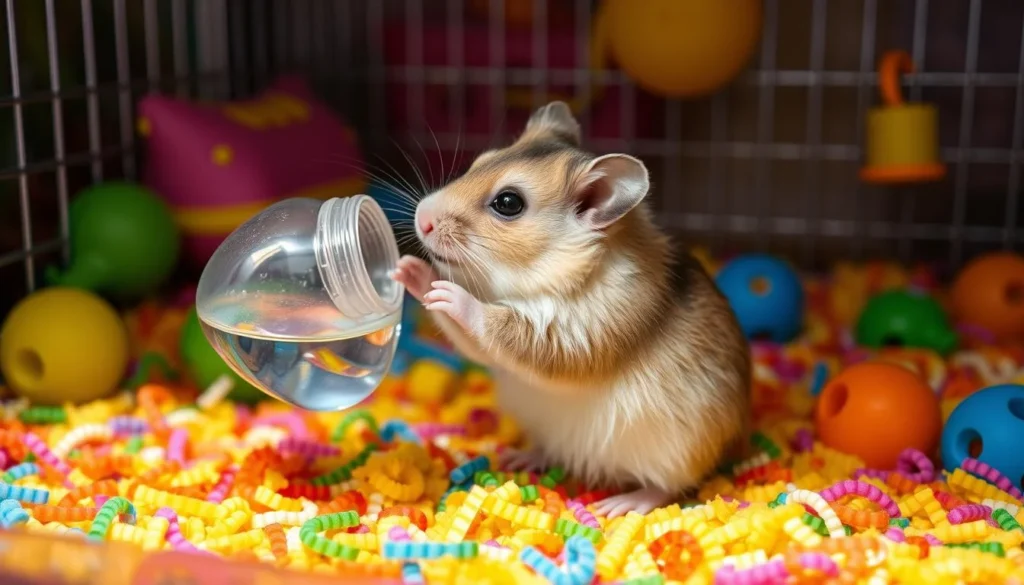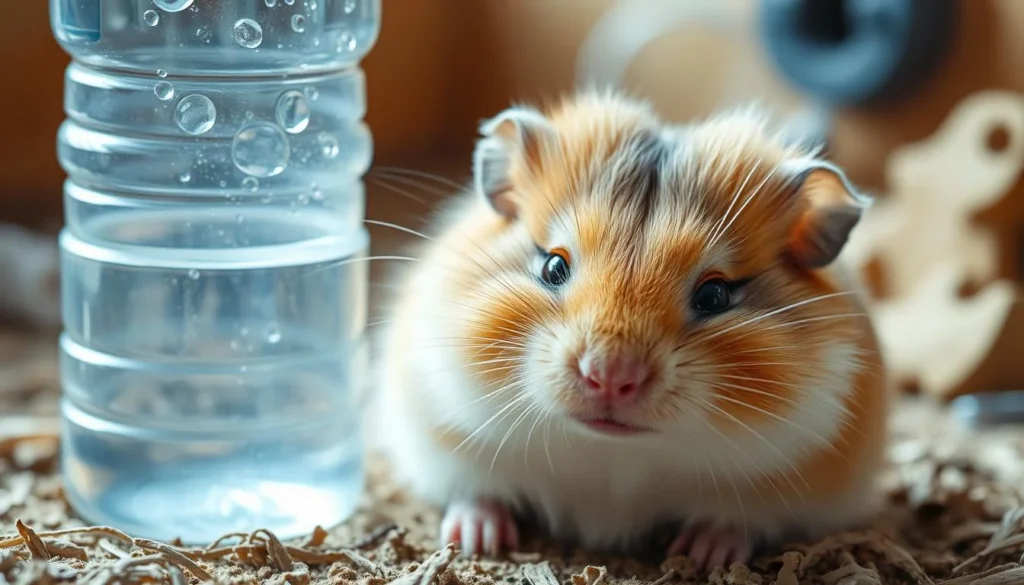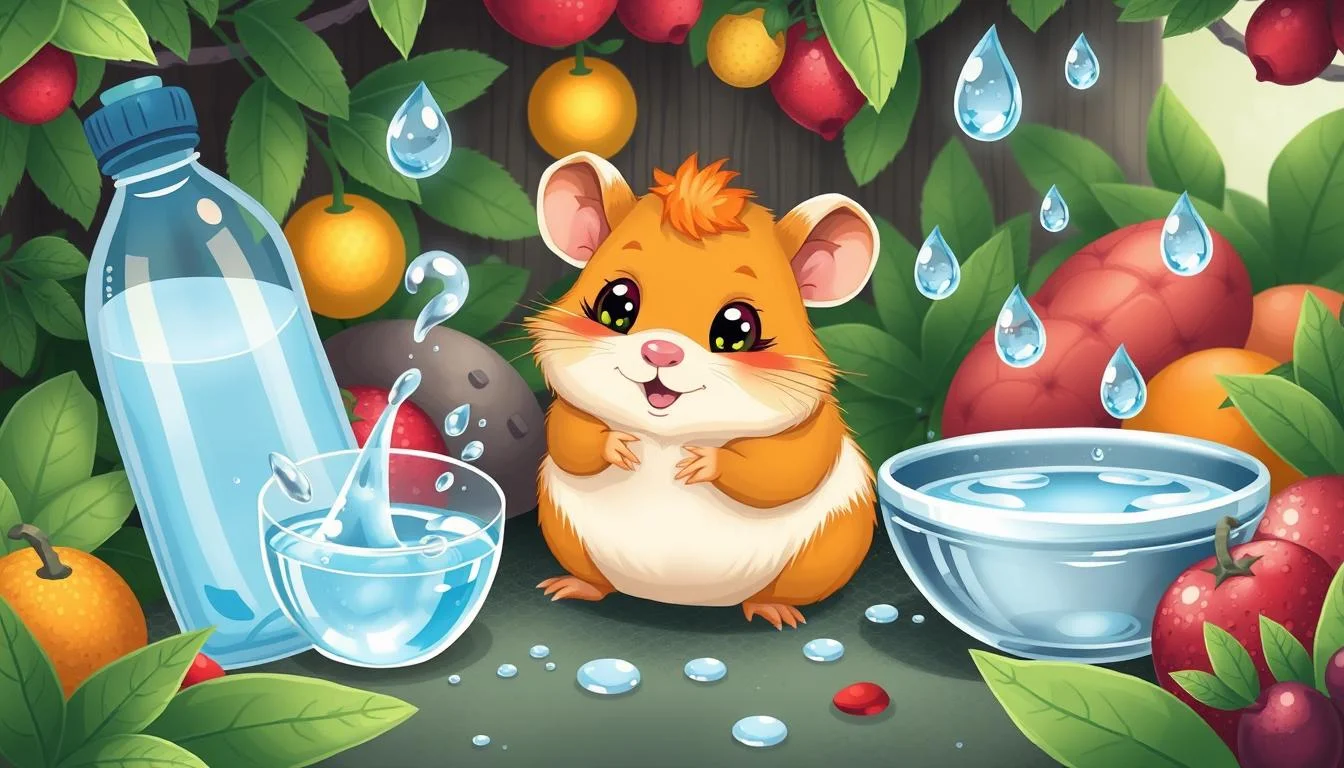Table of Contents
Every pet owner worries when their furry friend seems off. If your hamster is always drinking water, you’re not alone. It’s important to understand their hydration needs for their health and happiness.
Hamsters need water, but too much can mean health issues. Their water intake can tell you a lot. Sometimes, it’s a sign that needs quick attention.
As a hamster owner, knowing when to worry is key. This guide will help you understand why your hamster might be thirsty. It will also show you how to keep them healthy.
Key Takeaways
- Normal hamster water intake ranges from 3-5 mL per 100 grams of body weight
- Excessive thirst can indicate health problems
- Diet and environment affect water intake
- Watch your hamster’s drinking habits closely
- See a vet if your hamster drinks too much
Understanding Normal Hamster Drinking Habits
Hamsters, like other small rodents, have special ways of drinking water. Keeping them hydrated is vital for their health. Their water intake changes based on their age, diet, and health.

Hamsters are naturally curious and need clean water always. They might drink less than bigger pets, but their hydration needs are important.
Daily Water Requirements for Adult Hamsters
Adult hamsters need about 10-20 ml of water each day. The exact amount depends on several things:
- Body weight
- Diet composition
- Environmental temperature
- Activity level
Signs of Normal Hydration Levels
Watching your hamster’s water intake is key to their health. Look for these signs of good hydration:
- Elastic skin that quickly returns to normal when gently pinched
- Bright, alert eyes
- Consistent energy levels
- Regular bathroom habits
Water Bottles vs. Water Bowls
Experts usually suggest using water bottles for hamsters. Water bottles have many benefits:
- Prevents contamination from bedding
- Keeps water cleaner longer
- Reduces spillage
- Easier to track daily water intake
“A well-hydrated hamster is a happy and healthy companion.” – Veterinary Rodent Experts
Knowing how your hamster drinks water is essential for their care. Keep an eye on their water intake and see a vet if you notice big changes.
Signs of a Thirsty Hamster: When to Be Concerned

It’s important to know when your hamster is thirsty. This can mean they have a health issue that needs quick help. Keeping an eye on how much they drink can stop big problems.
Look out for these signs of hydration trouble:
- Unusually frequent water bottle visits
- Sunken or dull-looking eyes
- Dry, sticky gums
- Decreased activity levels
- Wrinkled or less elastic skin
A dehydrated hamster might act differently. Lethargy and reduced movement are big warning signs. If your hamster is less active or always near water, it could be a serious issue.
“Early detection of hydration issues can prevent long-term health complications for your small pet.” – Veterinary Small Animal Experts
How your hamster looks can tell you about their hydration. A rough coat or sudden weight loss means they might need a vet. If changes last more than a day or two, see a vet right away.
Make sure your hamster always has water and check on them daily. This keeps them healthy and happy.
Common Medical Conditions Causing Excessive Thirst
Understanding your hamster’s health is key in pet care. Unusual drinking habits might mean there’s a health issue. Spotting these problems early can help your pet get the care they need.
Diabetes and Blood Sugar Challenges
Hamsters can get diabetes, which changes how much water they drink. Look out for these signs:
- Frequent urination
- Increased thirst
- Sudden weight loss
- Reduced energy levels
Kidney Function Complications
Kidney issues can mess with your hamster’s water balance. If their kidneys aren’t working right, they might drink too much water.
Hormonal Imbalances
Hormonal changes can make your hamster drink more water than usual. These changes need a vet’s attention to keep your pet healthy.
“Understanding your hamster’s health signals is key for the best pet care.” – Veterinary Experts
If your hamster’s drinking habits change, see a vet right away.
Environmental Factors Affecting Water Consumption
When you care for small rodents like hamsters, knowing how the environment affects their water use is key. Temperature and the setup of their habitat are very important for their hydration.
The room temperature greatly affects how much water your hamster drinks. They do best in temperatures between 65-75°F. If it’s warmer, they might drink more often.
- High temperatures increase water requirements
- Dry air can lead to faster dehydration
- Humidity levels affect hydration needs
Humidity is also very important for your hamster’s water needs. If the air is too dry, they can lose water quickly. Here are some tips to keep the right humidity:
- Place water bottle in a cool, shaded area
- Avoid direct sunlight near the cage
- Use a hygrometer to monitor humidity levels
“A comfortable environment is key to preventing excessive water consumption in hamsters.” – Veterinary Small Animal Care Guide
The way you set up your hamster’s cage is also important. Make sure it has good air flow. Avoid putting it near heaters or air conditioning vents. These can really affect how much water your hamster drinks and their health.
Diet-Related Causes of Increased Water Intake
Your hamster’s diet is key to its hydration. Knowing how food affects water intake helps in caring for your pet.
Impact of Dry Food Diet
Dry food is common in hamster diets but raises their thirst. Hamsters need about 10 milliliters of water for every 100 grams of body weight. A diet mostly of dry pellets makes them drink more to get moisture.
- Dry pellets have little water
- More water helps break down dry food
- Balance dry food with water-rich options
Salt Content in Treats
Watch the salt in your hamster’s treats. High-sodium snacks can make them thirsty and dehydrated. Choose treats that help keep your hamster hydrated.
“Moderation is key when giving salty treats to your hamster.”
Fresh Food Balance
Fresh foods can help manage your hamster’s water intake. Vegetables like cucumber and lettuce offer natural hydration. A balanced diet with both dry and fresh foods supports overall health and helps regulate water consumption.
- Introduce water-rich vegetables gradually
- Watch how your hamster reacts to diet changes
- Get advice from a vet for your hamster’s diet
Every hamster is different. Watch your pet’s hydration needs and adjust their diet for their health.
Proper Hydration Setup for Your Hamster
Setting up the right hydration system is key for your hamster’s health. Water bottles are vital hamster accessories that keep your pet hydrated. The right bottle can greatly improve your pet’s comfort and health.
When picking water bottles for your hamster, think about these important points:
- Bottle size that fits your hamster’s cage
- Easy-to-clean design
- Leak-proof mechanism
- Comfortable drinking nozzle
Where you place the water bottles is very important. Put the bottle so your hamster can easily drink without straining. Mount it about 2-3 inches above the cage floor.
“Clean water is the lifeline of your hamster’s health” – Veterinary Hamster Care Guide
Keeping hamster accessories clean is a must. Clean your water bottles every week with a mild, pet-safe cleaner. Change the water every day to keep it fresh and prevent bacteria.
- Check water bottle seal daily
- Inspect for any cracks or damage
- Ensure smooth water flow
Some hamsters might not drink much. Here are some tips to help:
– Place a small treat near the water bottle
– Make sure the water is at room temperature
– Check that the bottle’s nozzle works well
Monitoring Your Hamster’s Water Consumption
It’s important to keep an eye on how much water your hamster drinks. This helps spot health problems early. You need to pay close attention and watch regularly.
Daily Water Intake Tracking
Here are some ways to track your hamster’s water intake:
- Mark the water bottle’s initial level each morning
- Use a small ruler to measure daily consumption
- Keep a digital log or journal
- Check water levels at consistent times
Warning Signs of Dehydration
Knowing the signs of dehydration is key. Look out for these signs:
- Skin elasticity changes: Gently pinch the skin; slow return indicates dehydration
- Reduced activity levels
- Dry or sticky mouth
- Sunken eyes
- Decreased urination
“Early detection of dehydration signs can save your hamster’s life.”
Kidney disease can quickly develop in hamsters, more so in females over one year. If your hamster drinks more water, it might be a sign of a problem. Always see a vet if you notice big changes in drinking habits or think your hamster might be dehydrated.
When to Seek Veterinary Care
Watching your hamster’s water intake is key to their health. Knowing when to get vet help is vital. Some signs mean your hamster needs a doctor right away.
Look out for these important health signs that mean it’s time to call a vet:
- Sudden dramatic increase in water consumption
- Rapid weight loss
- Lethargy during typical active hours
- Fur appears dull or starts falling out quickly
- Visible signs of dehydration
Here are specific symptoms that need vet care fast:
- Excessive urination coupled with constant thirst
- Puffy cheeks or inflamed eyes
- Runny nose or respiratory difficulties
- Skin that doesn’t snap back when gently pinched
“Early detection can prevent serious health complications in hamsters.” – Veterinary Hamster Care Guidelines
Your vet will ask about your hamster’s recent behavior and diet. Keep a log of their water intake, eating, and any changes. This helps find the cause of their health issues.
Hamsters are very sensitive. Quick vet care can greatly improve their health and happiness.
Prevention Tips and Best Practices
Keeping your hamster healthy is more than just giving them water. About 20% of pet hamsters face hydration problems. So, it’s key for owners to know how to prevent these issues.
Here are some important tips for keeping your hamster hydrated:
- Create a stable environment with consistent temperature and humidity
- Invest in quality hamster accessories that support healthy drinking habits
- Incorporate exercise wheels to promote natural metabolic balance
- Monitor water intake daily
Your hamster’s hydration depends on many things. Exercise wheels are key to their health. Active hamsters drink water better, which helps avoid dehydration.
“A well-equipped habitat is the foundation of excellent pet care”
Regular vet visits are also important. Experts say to see a vet at least twice a year. This keeps your hamster healthy.
- Inspect water bottles weekly for cleanliness
- Replace water sources immediately if contamination is suspected
- Maintain consistent cage cleaning schedules
By following these tips, you’ll make sure your hamster stays hydrated and healthy.
Conclusion
Knowing how much water your hamster needs is key to good pet care. By understanding what affects their water intake, you can spot health issues early. Watching how much your hamster drinks helps keep them healthy.
There are many reasons why hamsters might drink a lot of water. These include their environment and health problems. Keeping an eye out for changes in their drinking habits is important.
If you notice your hamster drinking a lot more than usual, see a vet. Some changes are normal, but too much water can mean they’re sick. Taking care of your hamster’s water needs helps them live a happy, long life.
Following the tips in this article can help your hamster stay healthy. Keep watching your hamster and learn about their needs. They will be full of energy and happy.
